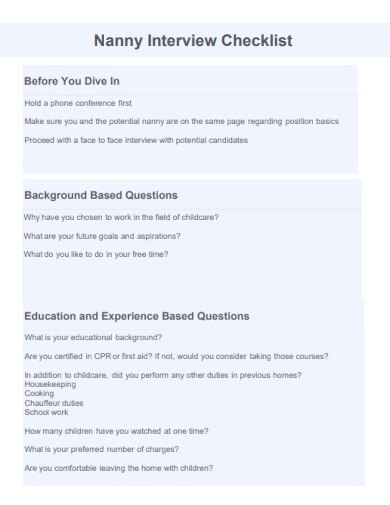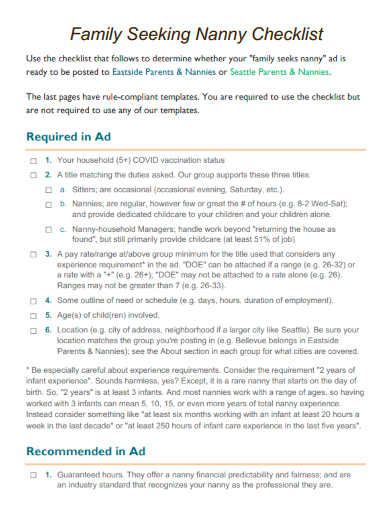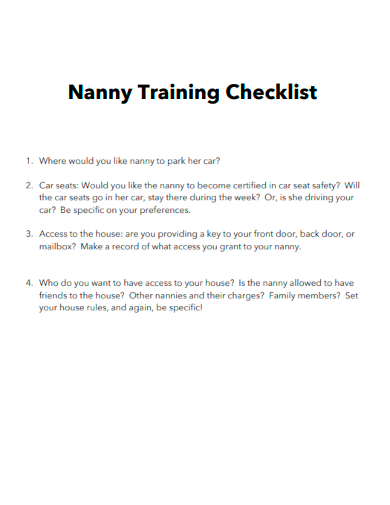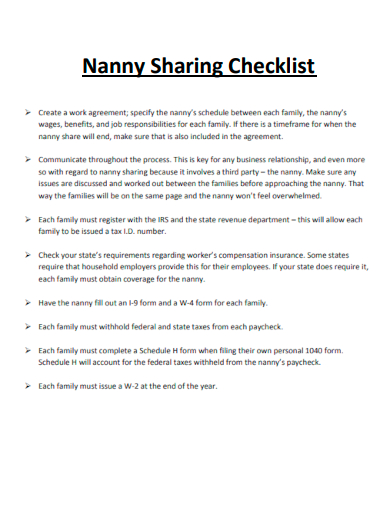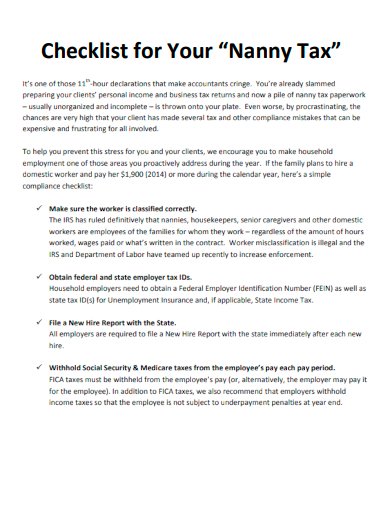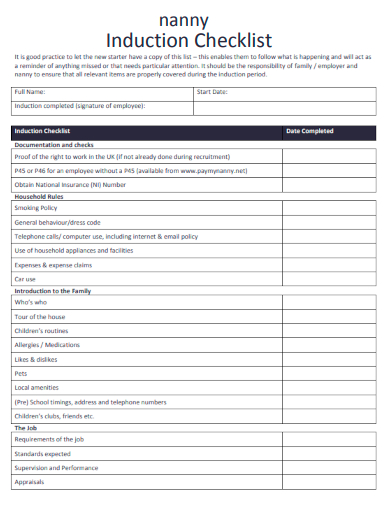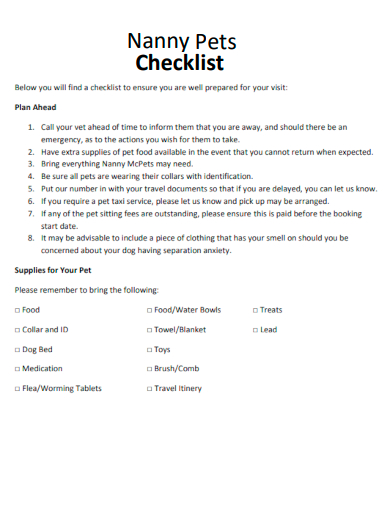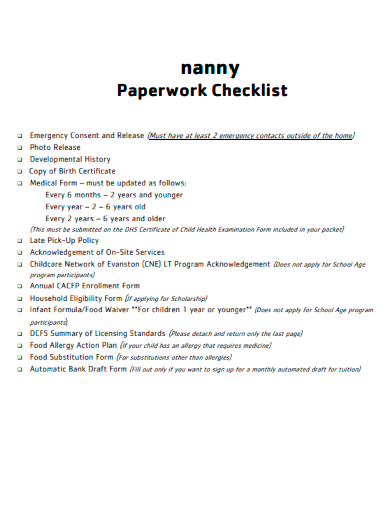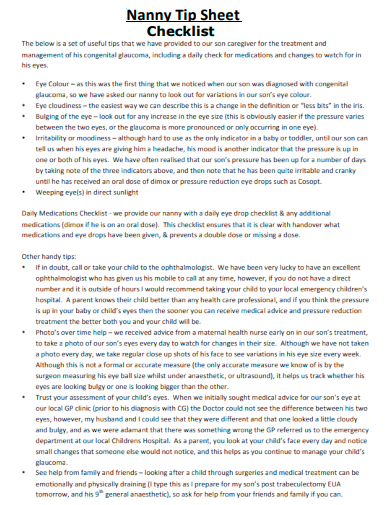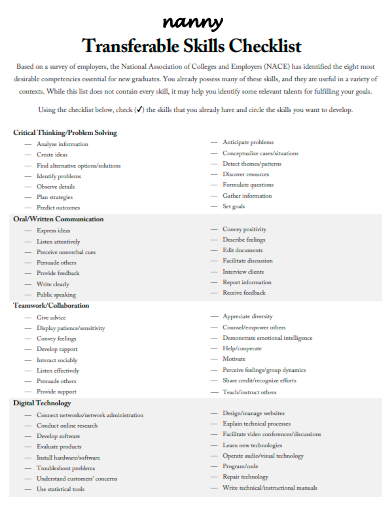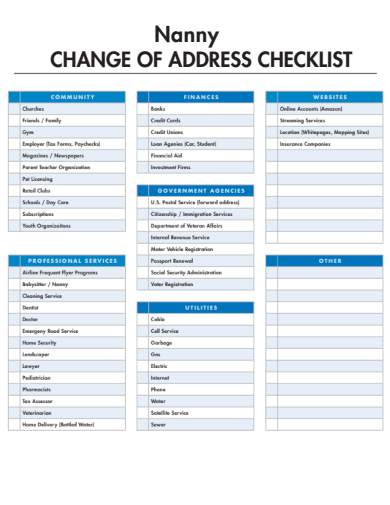Selecting the right nanny for your family is a pivotal decision. Our comprehensive Nanny Checklist ensures you make an informed choice, considering every vital aspect. From background checks to personality traits, this guide is brimming with essential pointers to help you navigate the search. Whether you’re a first-time parent or just looking to replace your current caregiver, our checklist is the definitive tool for a confident, informed selection.
FREE 15+ Nanny Checklist Samples
1. Sample Nanny Daily Checklist Template
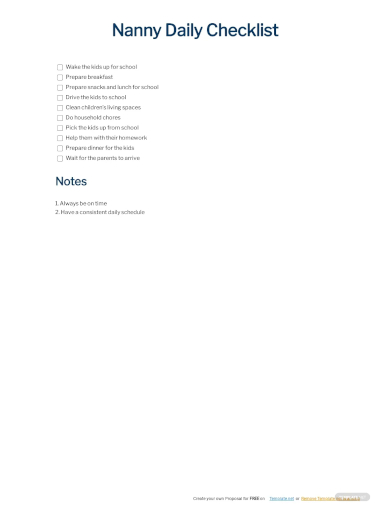
2. Sample Nanny Duties Checklist Template
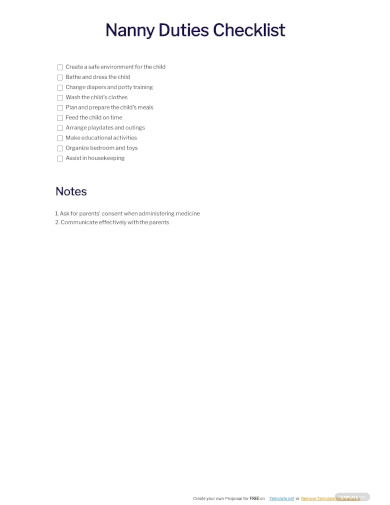
3. Sample Nanny Hiring Checklist Template
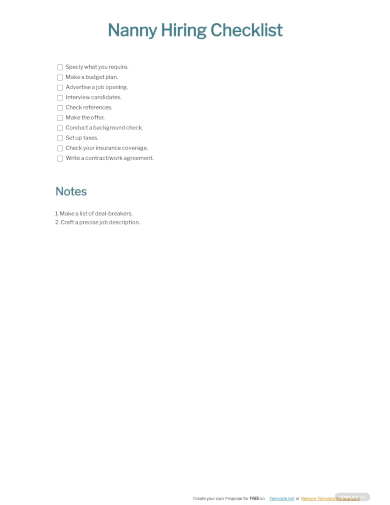
4. Sample Nanny Safety Checklist Template

5. Sample Nanny Weekly Checklist Template
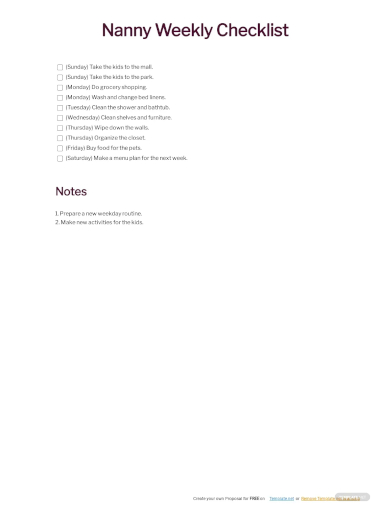
What is a Nanny Checklist?
A Nanny Checklist is an essential tool that parents use to ensure that the nanny they are hiring or have hired is well-informed about the family’s needs, expectations, and the daily routine that needs to be followed while taking care of the children. This checklist can cover a variety of topics, from the children’s dietary restrictions to emergency contacts, and can greatly help in making the nanny’s integration into the family smoother and more efficient.
Key Components of a Nanny Checklist:
The Key Components of a Nanny Checklist are essential elements that every family should consider when hiring a nanny. These components help in ensuring the nanny is a good fit for the family and is capable of providing a safe, nurturing environment for the children. Here are the key components of a Nanny Checklist:
- Experience and Qualifications: Families should look for nannies with relevant experience, sample certifications, and, if needed, educational qualifications. For instance, a nanny with a background in early childhood education might be preferable for families with toddlers.
- First Aid and CPR Training: It is essential that a nanny is equipped to handle emergencies, making first aid and CPR training a critical component of the checklist.
- Background Check and References: Safety is paramount. A thorough background check and contact with previous employers can provide insights into the reliability and integrity of the candidate.
- Driving Skills and Vehicle Safety: If the nanny will be driving the children, a clean driving record and a safe vehicle are indispensable.
- Personality and Values: A nanny’s personality should align with the family’s values and parenting style. Compatibility in this area ensures a cohesive and positive environment for the children.
- Availability and Flexibility: The nanny’s schedule should align with the family’s needs, and a degree of flexibility is beneficial for unforeseen circumstances or changes in routine.
Importance of a Nanny Checklist
A Nanny Checklist is essential for both families and nannies to ensure clear communication, manage expectations, and foster a positive working relationship. Here are several reasons why a Nanny Checklist is important:
1. Clear Expectations: A checklist helps in setting and clarifying expectations regarding duties, responsibilities, and behaviors, reducing the chances of misunderstandings or conflicts.
2. Task Management: The checklist can be used to sample outline the nanny’s daily, weekly, and monthly tasks, helping to manage time effectively and ensure that all duties are completed.
3. Safety: A checklist can include safety protocols and emergency contacts, ensuring that the nanny is well-prepared to handle any situation that may arise.
4. Communication: The checklist fosters open communication between the family and the nanny, enabling both parties to discuss needs, expectations, and any concerns.
5. Child’s Routine: Having a checklist helps the nanny maintain a consistent routine for the child, which is crucial for the child’s sense of security and development.
6. Evaluation and Feedback: The checklist can be used as a tool for regular evaluations, allowing both the family and the nanny to give and receive sample feedback, fostering continuous improvement.
7. Legal and Financial Clarity: The checklist can also include details on salary, benefits, estimated taxes, and legal responsibilities, ensuring transparency and compliance with applicable laws.
8. Health and Dietary Needs: The checklist can specify any health requirements, allergies, dietary restrictions, or preferences, helping the nanny to take better care of the child’s health and well-being.
9. Bonding and Relationship Building: By discussing and agreeing on the checklist, the family and the nanny can build a mutual understanding and trust, which is the foundation of a positive caregiving relationship.
10. Conflict Resolution: In case of disagreements or disputes, referring to the agreed-upon checklist can help in resolving issues in a constructive manner.
6. Sample Nanny Interview Checklist Template
7. Sample Family Seeking Nanny Checklist Template
8. Sample Nanny Training Checklist Template
9. Sample Nanny Sharing Checklist Template
10. Sample Nanny Tax Checklist Template
11. Sample Nanny Induction Checklist Template
12. Sample Nanny Pet Checklist Template
13. Sample Nanny Paperwork Checklist Template
14. Sample Nanny Tip Sheet Checklist Template
15. Sample Nanny Transferable Skills Checklist Template
16. Sample Nanny Change of Address Checklist Template
How do you Create an Nanny Checklist?
Hiring a nanny can be a significant step for families seeking support in child care. Creating a detailed nanny checklist is essential to ensure that both the nanny and the family have a clear, mutual understanding of expectations and responsibilities. Here’s a guide to creating a comprehensive nanny checklist in a few simple steps:
Step 1: Define Daily Routines and Schedules
Start by outlining the child’s daily routines and schedules. Detail meal times, nap times, school or activity schedules, and any other regular commitments. Clearly specify any tasks the nanny will be responsible for, such as preparing meals, organizing playdates, assisting with homework, or facilitating bedtime routines. This step sets a clear expectation of the nanny’s daily duties and helps maintain consistency in the child’s routine.
Step 2: Highlight Safety Protocols
Safety is paramount when it comes to child care. Clearly communicate any house rules, emergency contacts, and safety procedures. Provide information on first aid supplies, fire extinguishers, and the locations of exits. Additionally, discuss any allergies, medications, or specific health concerns related to the child, ensuring the nanny is well-prepared to handle any situation that may arise.
Step 3: Outline Behavioral Expectations and Discipline
Every family has its approach to discipline and plan of behavior management. Discuss and document the family’s philosophy and strategies for handling behavioral issues. Clearly outline what behaviors are unacceptable and the appropriate responses or consequences. Establishing this understanding ensures consistency in managing behavior and reinforces the child’s sense of security.
Step 4: Specify Communication Preferences
Open and regular communication between the family and the nanny is crucial. Determine the preferred methods of communication, whether it be text, call, email, or face-to-face conversations. Establish regular check-ins to discuss the child’s development, any concerns, and share feedback. Clear communication builds a strong, positive relationship and helps address any issues promptly.
Step 5: Address Financial and Legal Aspects
It’s important to be transparent about the financial and legal aspects of the nanny’s employment. Clearly outline the payment schedule, salary, overtime rates, and any benefits such as health insurance or vacation days. Discuss the terms of employment, confidentiality agreement, and any other legal considerations to ensure a mutual understanding and avoid any future disputes.
In Conclusion, A nanny checklist is more than just a set of instructions; it’s a communication tool that bridges the gap between parents and caregivers, ensuring the child’s safety, happiness, and development. By being thorough and attentive to detail, parents can create a tailored checklist that serves as a foundation for a trusting and beneficial relationship between the child, the nanny, and themselves.
Related Posts
Argumentative Writing Samples & Templates
FREE 11+ Interior Design Contract Samples in PDF | MS Word | Google Docs | Apple Pages
FREE 3+ Management Weekly Report Samples in PDF | DOC
FREE 10+ Sample Residential Contract Templates in PDF | MS Word
FREE 10+ Process Safety Management Samples in PDF | DOC
FREE 8+ Project Stakeholder Management Samples in PDF | DOC
FREE 10+ Warehouse Management Samples in PDF | DOC
FREE 7+ Investment Management Contract Samples in PDF | MS Word
FREE 13+ Credit Risk Management Samples in PDF | MS Word
FREE 5+ Brand Risk Management Samples in PDF | DOC
5+ Forex Risk Management Samples in PDF | DOC
FREE 15+ Site Investigation Report Samples in PDF | DOC
FREE 5+ Venture Capital Risk Management Samples in PDF | DOC
FREE 5+ Investigation Log Samples in PDF | DOC
FREE 6+ Inventory Risk Management Samples in PDF | DOC

